Strolling the streets of Villa de Leyva is like entering a magic kingdom, with its whitewashed houses, red-tiled roofs and cobblestoned streets. so it is only fitting that on the outskirts of this photogenic little village, lies the Casa Terracotta.

This home took environmental architect Octavio Mendoza almost 20 years to complete. It is a staggering 5400 square feet, and is built entirely of clay, without one single piece of rebar or concrete for reinforcement. It was created much like any piece of pottery, by being fired in an oven that covered each part of the structure for weeks. It is all entirely made by hand, and is a fully functioning home, powered by solar, with running water, electricity and even Wifi.

The house was originally intended as a home for the architect, but he had so many curious (and uninvited) people dropping by, that he opened it to the public and built himself another home. Terracotta Casa is a half-hour walk from town and we were lucky to arrive just as an English/Spanish tour was beginning. Our guide explained that some of the artistic influences came from Spanish architect Gaudi, as you can see from the flowing and whimsical Hobbit-like lines.
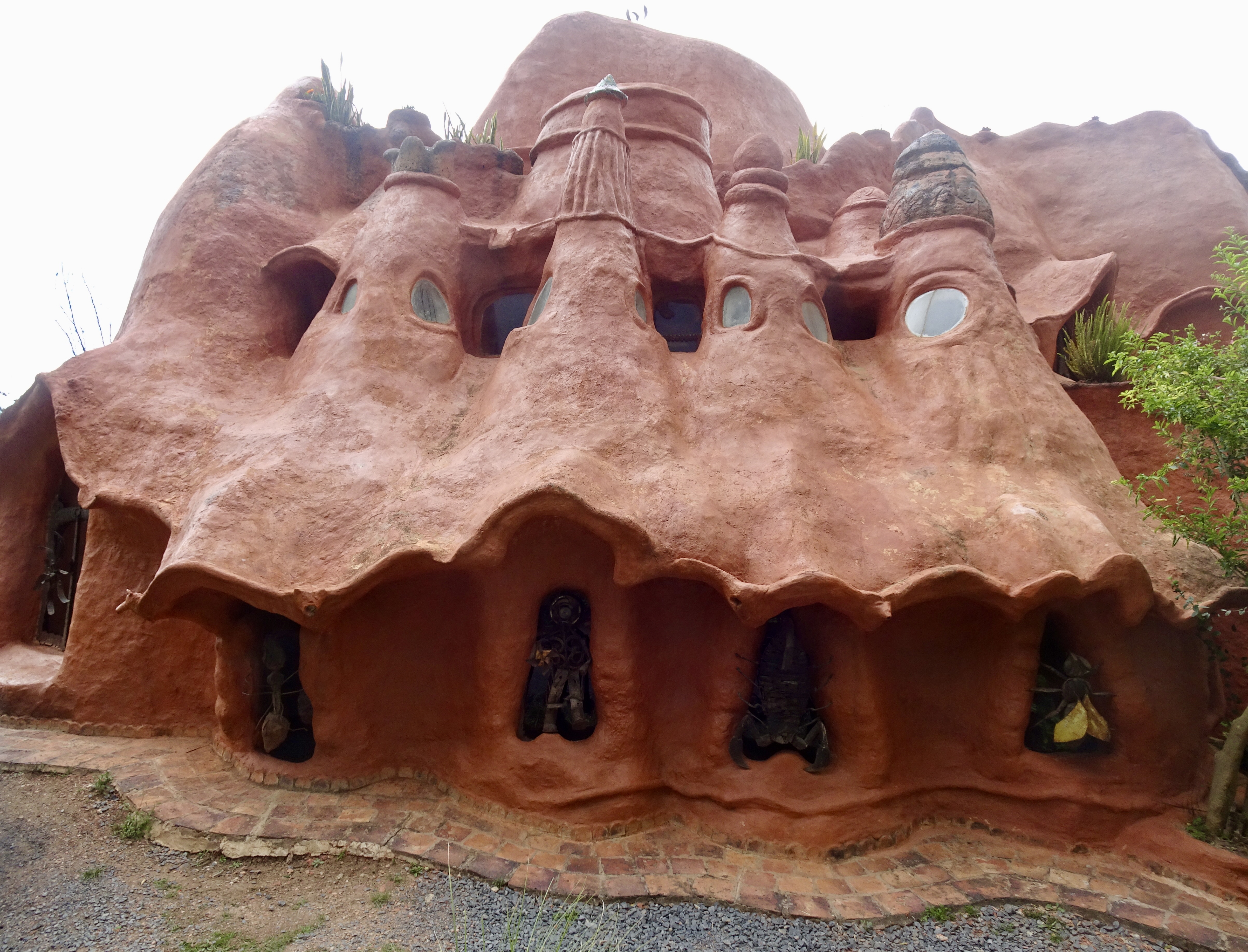
A narrow walkway runs across much of the second floor, and of course, aside from being a fascinating study in construction, it is also amusing to note that these low and unprotected walls would never fly in Canada or the U.S.

We roamed around the interior of the home, but it was difficult to take good photos, as everything was dimly lit and constructed of narrow hallways which blocked the natural light.
This is the entrance to the home, with the kitchen and dining room leading to the left and the stairs leading up to the bedrooms.
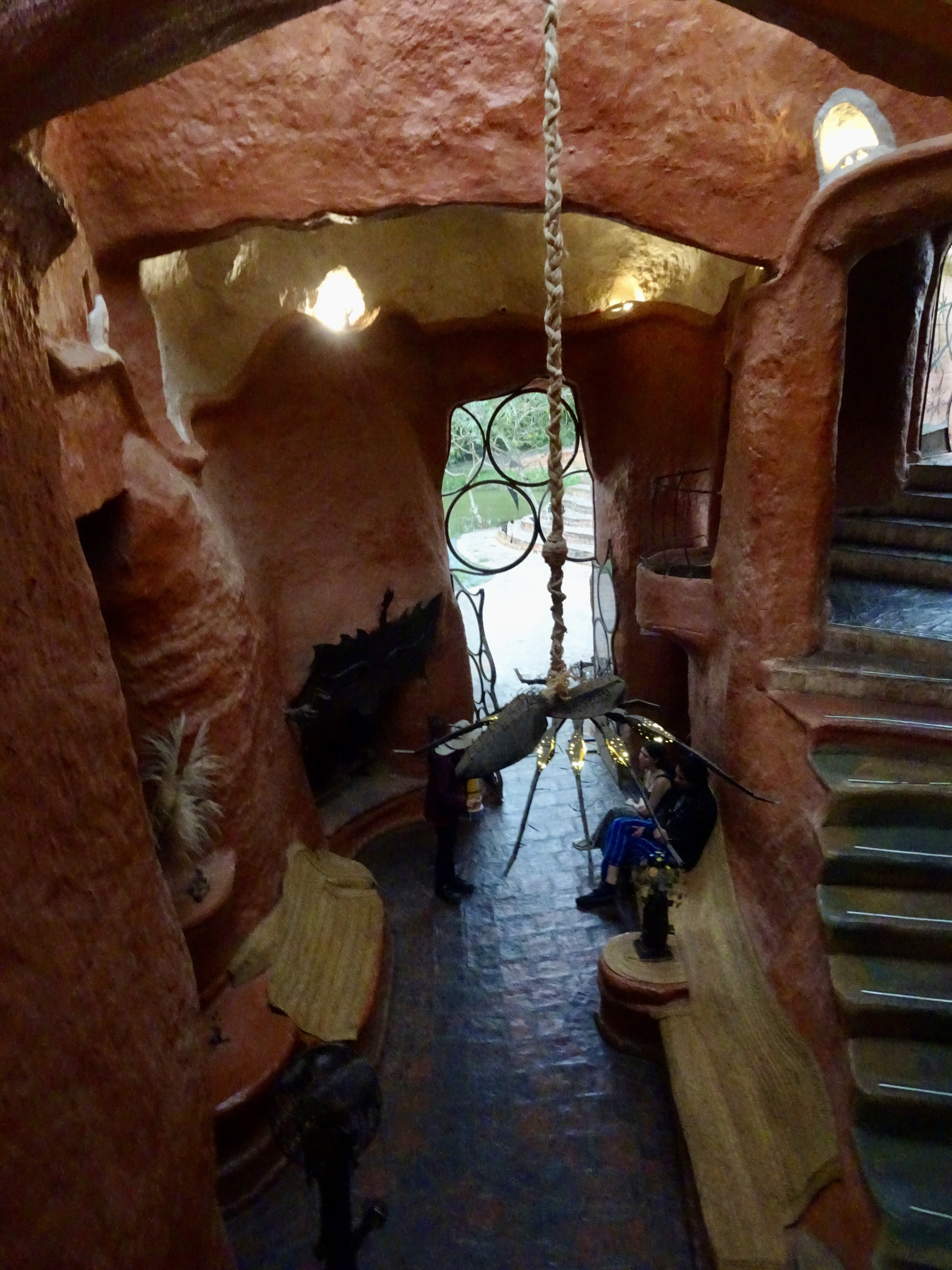
The house is dramatically backlit by the thunderstorm that threatened us the entire time we were there. We managed to complete the tour, walk the half hour back to our hotel and race to our room just ahead of the deluge.
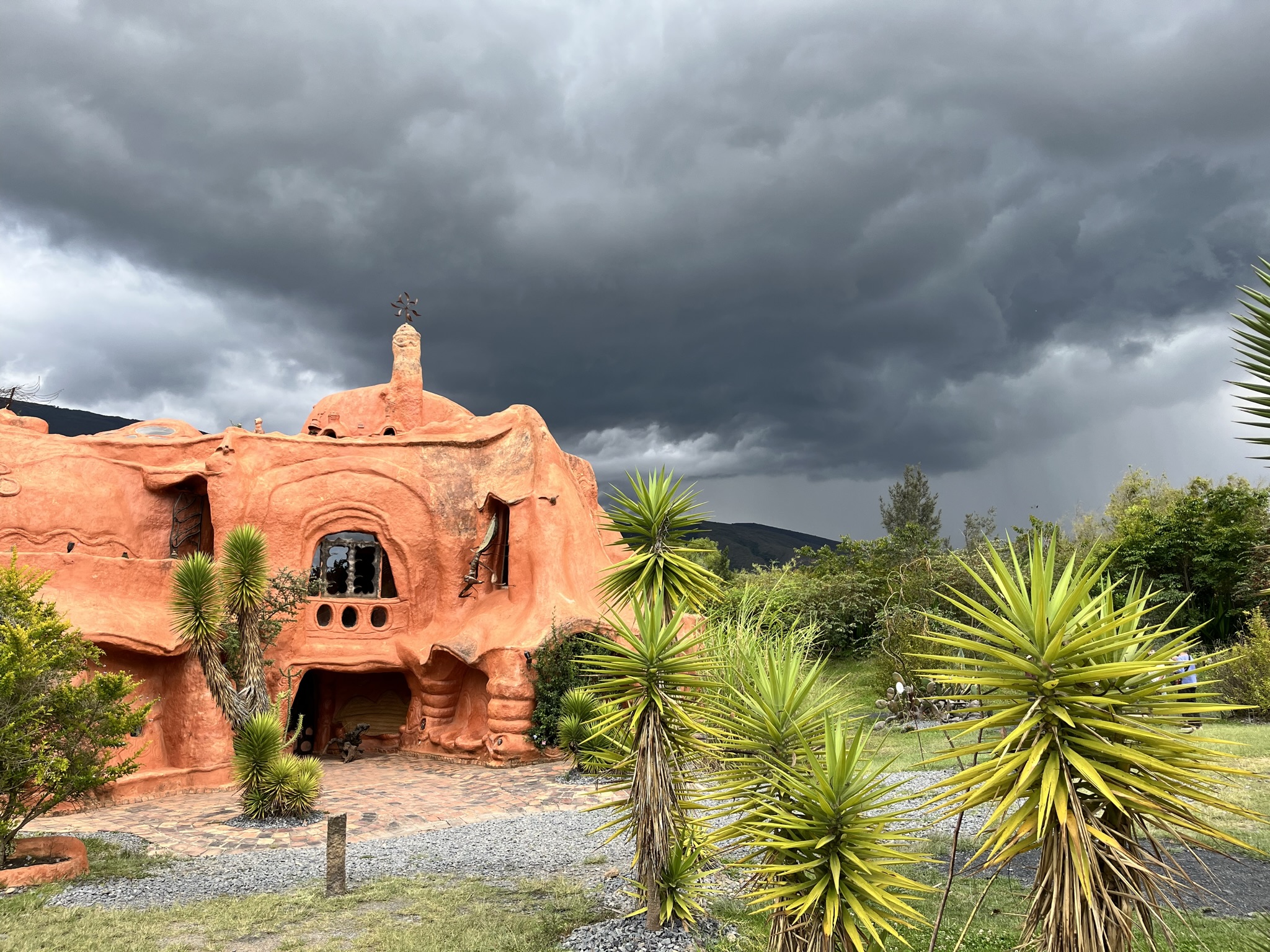
Which brings us to the weather we have experienced so far – a little cooler and a lot wetter than we anticipated, thanks to the lingering effects of El Nino this year. There is a reliable pattern though – we wake up to clouds that blow off by 7:30 or 8:00. The morning is usually sunny with dramatic white clouds that gradually turn grey, and by 2:00 or 3:00, the rain begins. Torrential rain that is almost impossible to protect oneself from, with small rivers rushing down the streets, and with any luck, thunderstorms. Since we so seldom get thunderstorms on the west coast, these are a huge treat to watch. Then… in typical Latin fashion, the tempest and drama is over and everyone emerges on the street again.
And so, on to the main event, the enchanting village of Villa de Leyva which was founded in 1572 and in 1954, was awarded National Monument status in recognition of its well-preserved colonial architecture. This village possesses a number of interesting distinctions.
The main plaza, Plaza Mayor, is one of the largest in Latin America. It is also the site of the Astronomical Festival, held in late January. This has been a natural astronomical observatory since pre-Colombian times, and astronomy associations meet each year to exchange experiences, knowledge and latest technology.

The main church flanks one side of the plaza and is lined with benches where citizens and tourists alike sit in the shade and people-watch.
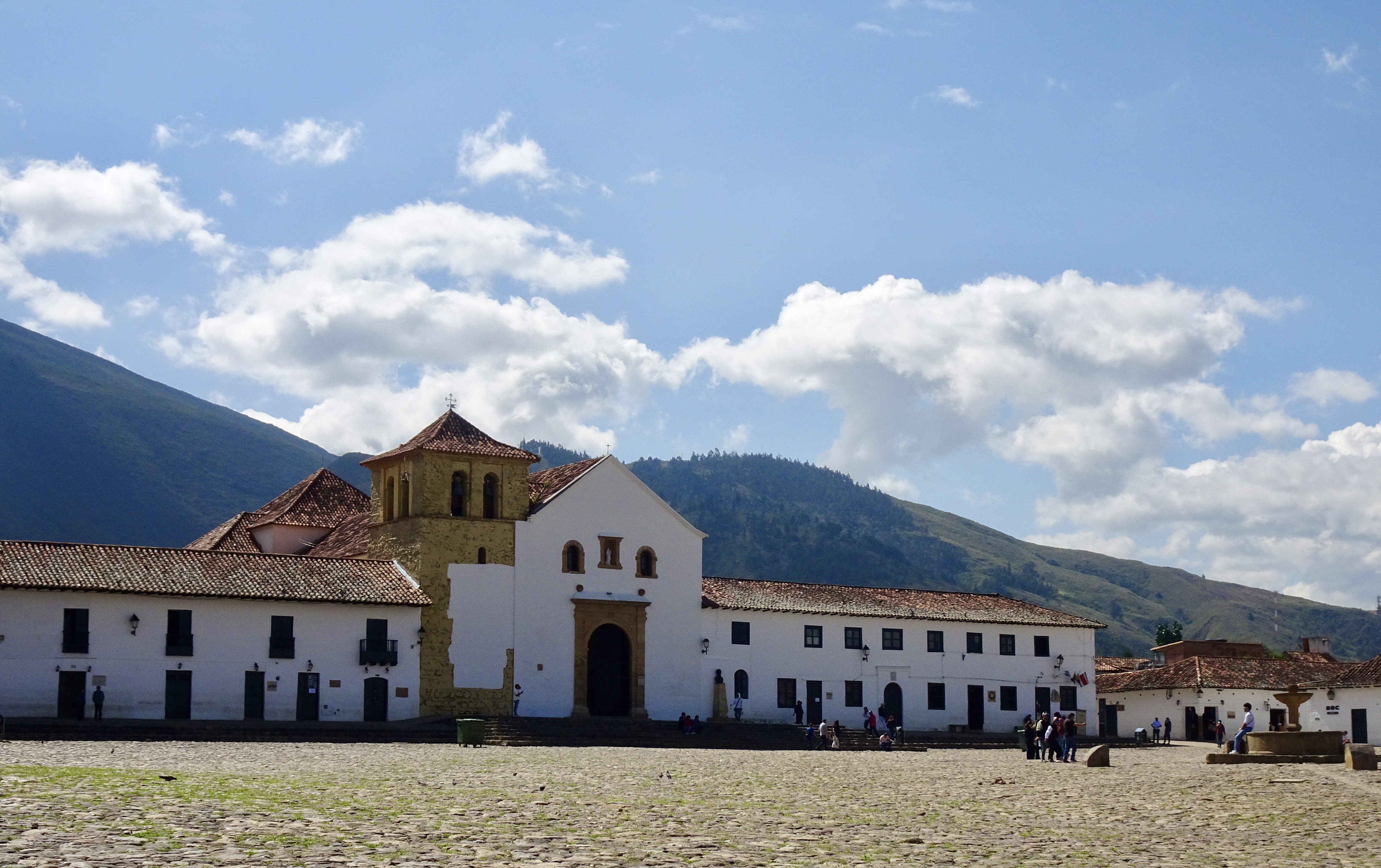
Our hotel is just around the corner from Plaza Major, and was once the home of Colombian author Luis Vargas Tejada, who, according to Wikipedia, died at age 27, while trying to swim across a river from Venezuela.
This is the view from our bedroom:

This is the front courtyard. If you look at the bricks that form the courtyard, they are filled with fossils, which are found everywhere in the area. Villa de Leyva was originally a sea that created an important paleontological area.
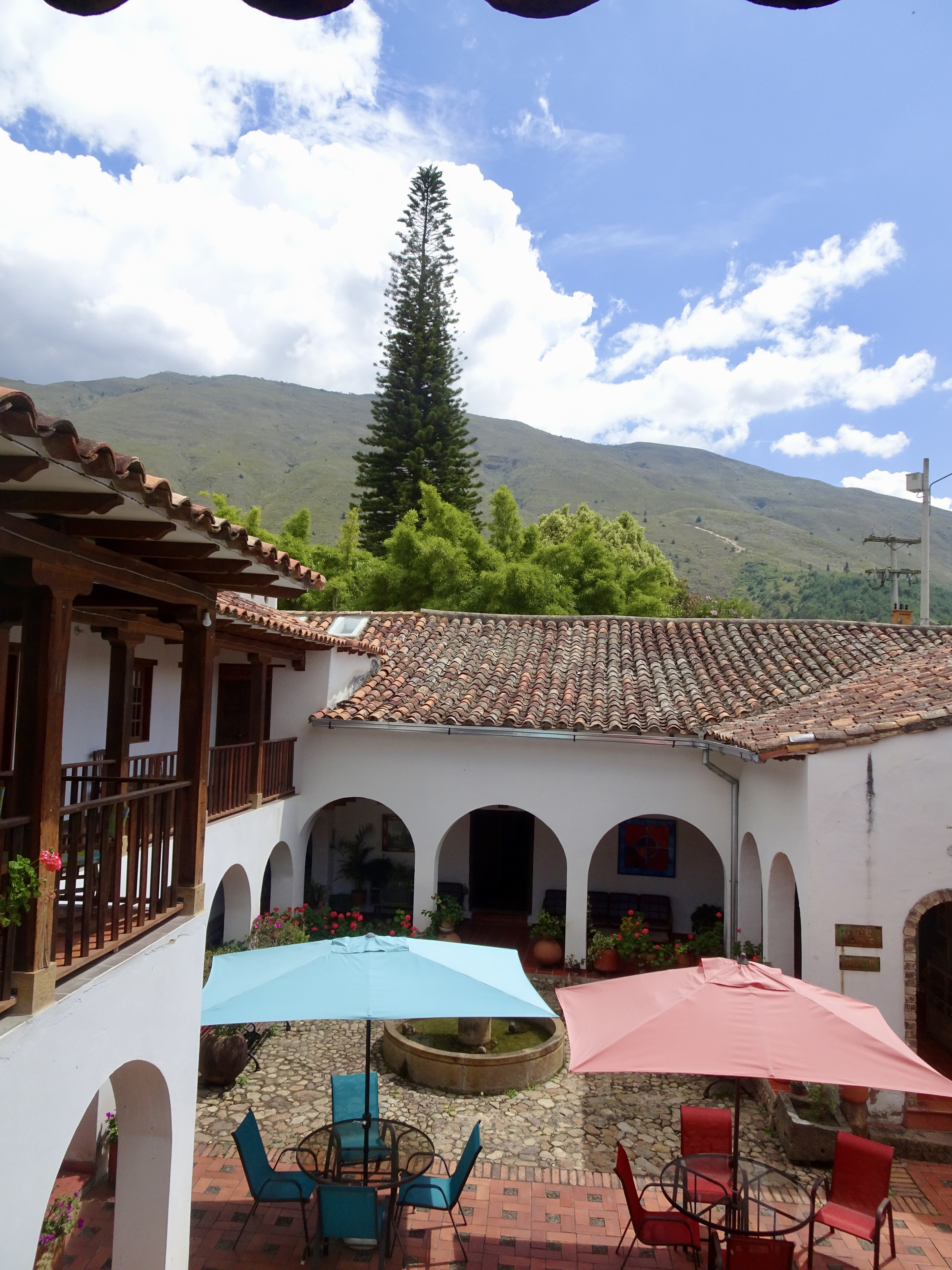
The pure joy of Villa de Leyva, beside being esthetically pleasing to the eye, is the ability to walk everywhere. It is a small village, impossible to get lost and no neighbourhoods to avoid, so the treat comes from the aimless wander. Take a look at the streets. With the exception of the paved peripheral roads, everything is cobblestone.
Cars tend to drive extremely slowly and motorbikes fly by – I’m assuming they need to maintain momentum to avoid wheels being stuck in the grooves. As for walking – once again, I feel fresh respect for Colombian women who navigate in heels: I am grateful for my sturdy walking shoes.

The streets are hilly, and every corner brings a fresh and interesting sightline.

There are a couple of main shopping streets that run parallel to the mountain; side streets run perpendicular up the hill.
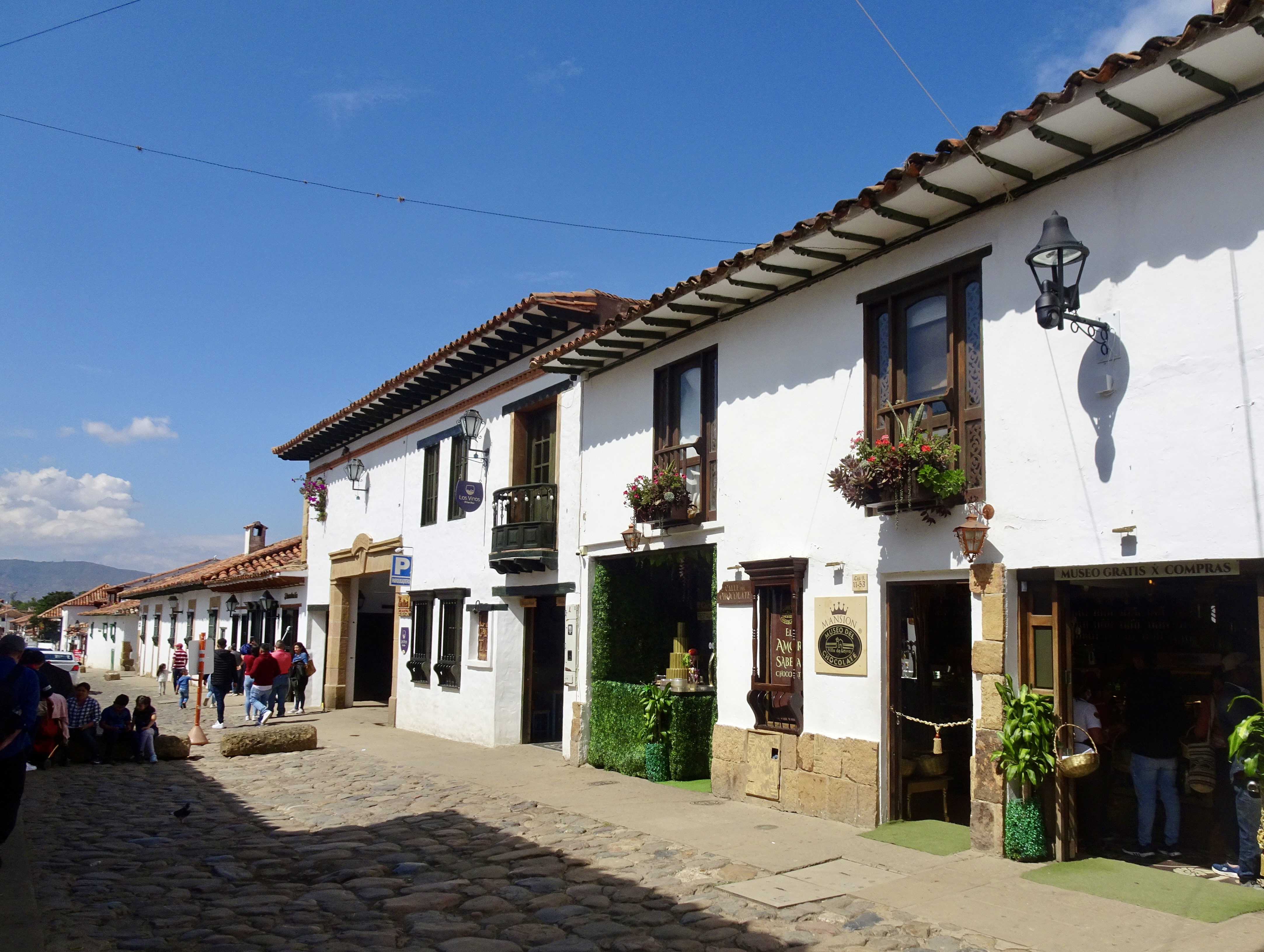


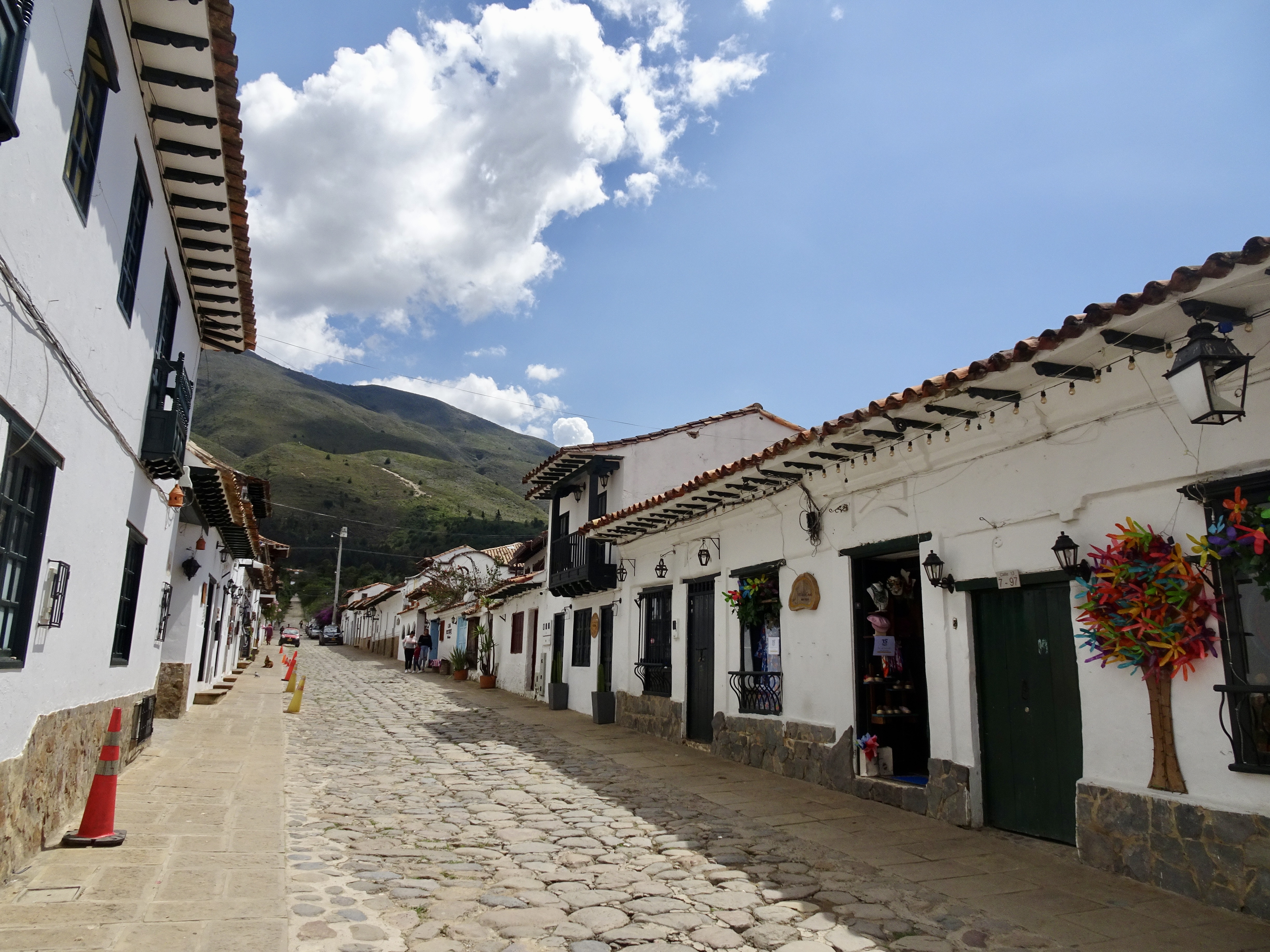
What is so remarkable about Villa de Leyva is how uniformly beautiful it is. We walked back streets and well away from the centre, and even if some streets were more modest in appearance, nothing was run-down or shabby or neglected looking. It seems to be a collective pride that shines in doorways, in small stores and in simple, but well-designed window displays.
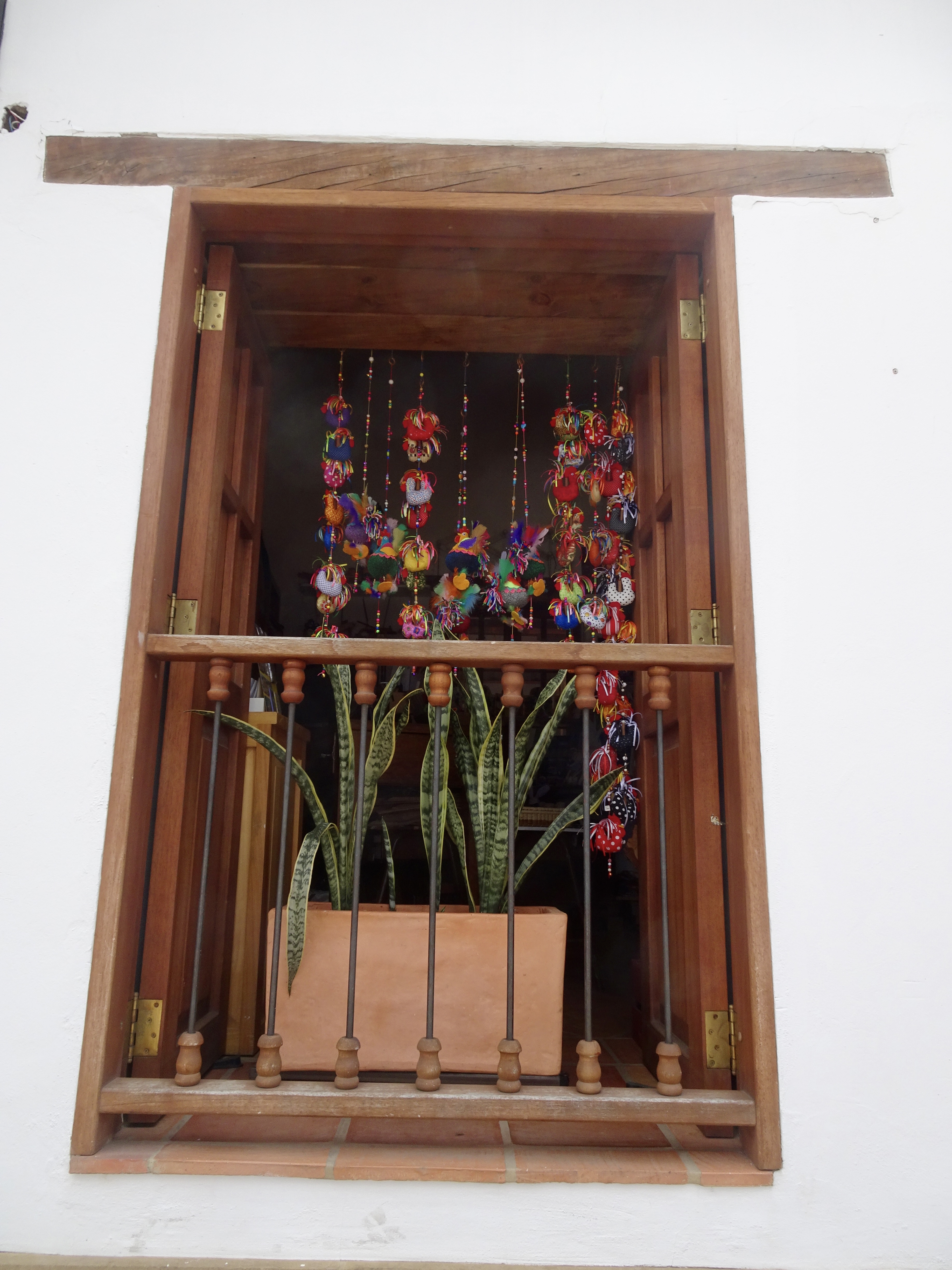
Food in Colombia is wonderful. We ate beautiful, clean, fresh and delicious food in Bogota – I don’t know how I forgot to talk about it. The same in Villa de Leyva – we have eaten very well here. We discovered a little complex that offers food from about eight different outlets – Colombian, Italian, Greek, sushi, etc. You find a table, scan the menus, pick what you want and servers bring everything to you. Food was great, surroundings were very stylish, and we even found a server who spoke a bit of English.
Food is extremely affordable here – we are averaging $15-$25 for lunches and dinners (including a beer at dinner). Groceries are very affordable as well, by our standards, although we were told that the Russian invasion on Ukraine has had a terrible effect on food prices here.
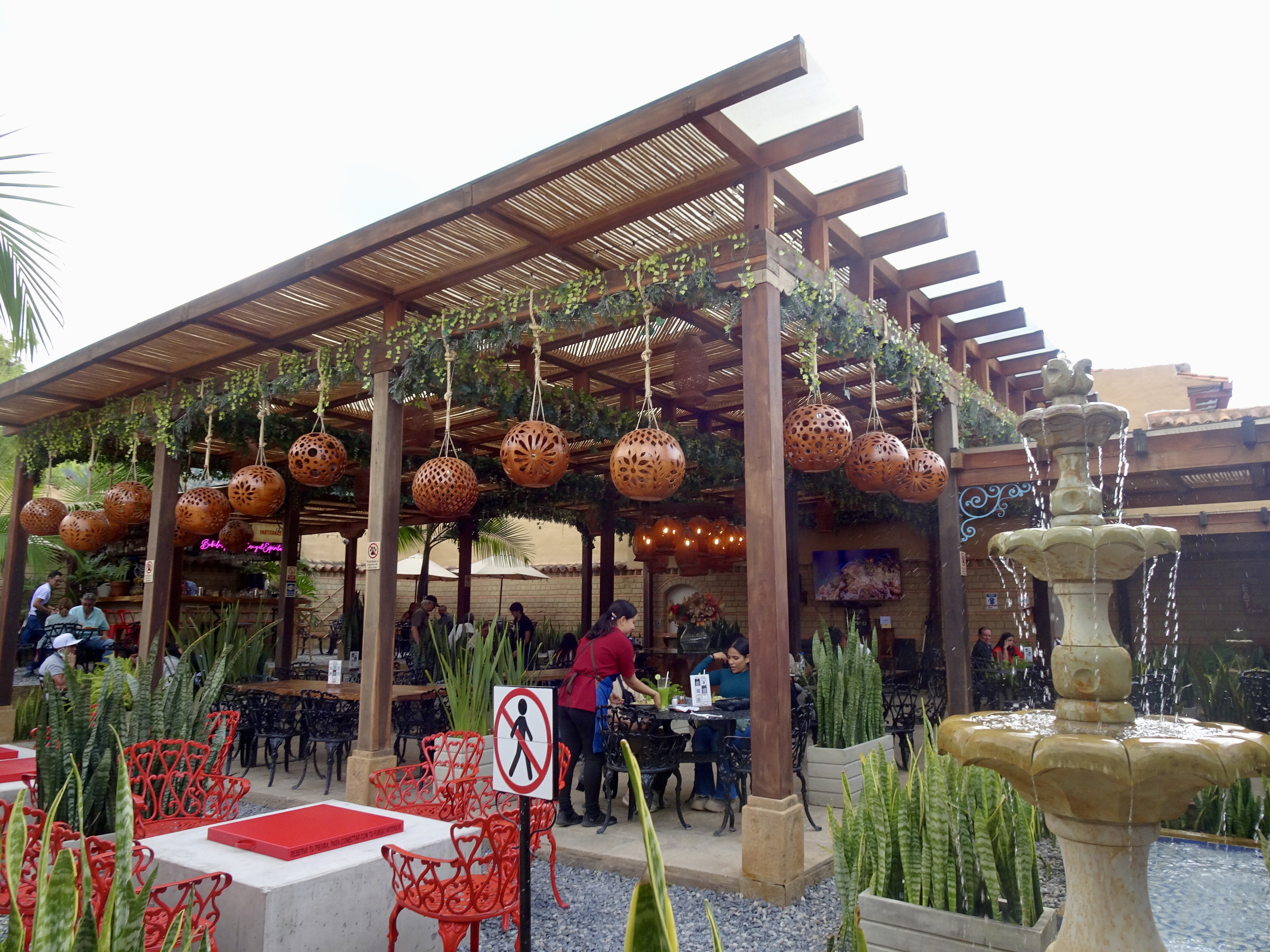
You know when something sounds like a great idea? You read about a hike that promises to be a couple of kilometres and the reward will be a panoramic view. Perfect – we set off for El Mirador, and after a bit of challenge finding the entrance, we stared up at what looked like a rock face. A wet, slippery rock face, after yesterday’s overnight rainfall. A little doubtful, but we figured the hike would soon straighten out to a real path, so away we went.
Except, there never was a path, it was only rocks and more rocks, most of which we climbed on our hands and knees. At one point, a young, shirtless man RAN down past us, and a few minutes later, he RAN back up again. By now, we are puffing and wheezing and hanging on to the rocks, with images of sprained ankles and worse running through our heads. About an hour up, we stopped and decided enough was enough – nothing to prove and the potential for injury not insignificant. A charming Frenchman stopped by on his way down, and assured us that with still an hour to go and a “really dangerous ” section, we could be forgiven for calling it a day. So we did. This was not the panoramic shot we had hoped for, but the best we could do.
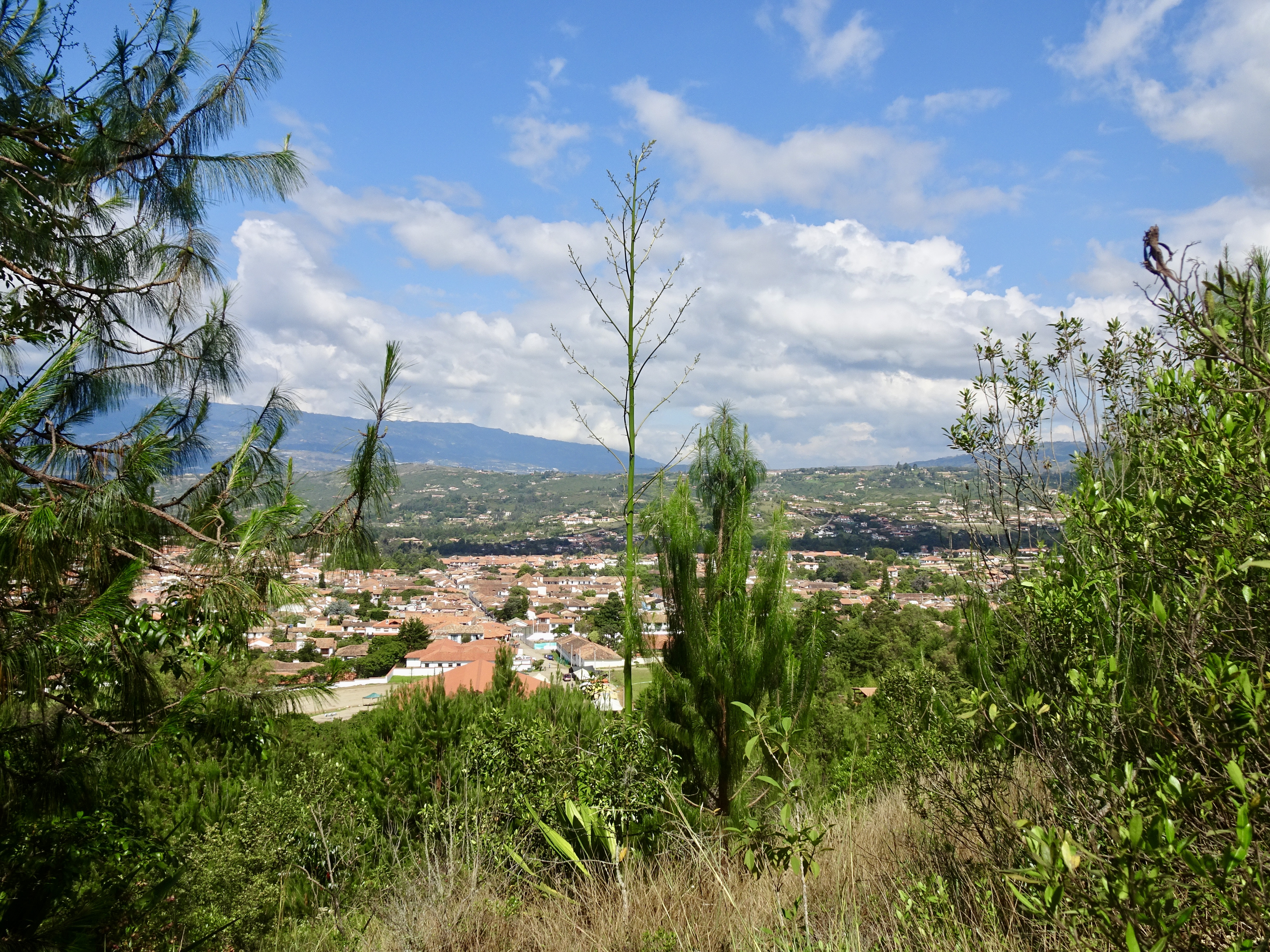
And, just like that, our delightful respite in Villa de Leyva is over. A perfect bridge from the chaos of Bogota and a nice intro into the diverse countryside of Colombia. Tomorrow, we are off for Barichara, were we will spend six nights – lots to explore in that area.
What a stunning village. Casa Terracotta looks amazing. I’m sure Gaudi would give two thumbs up! Thank you for sharing your wonderful photos and (always) brilliant descriptions. It’s a joy being an “armchair” traveller with you both at the helm. Can’t wait for the next stop. All aboard!! Cheers, Michelle
LikeLike
Thanks Michelle! We’ve been trying to get here for three years – feels a bit surreal to actually be in Colombia now.
LikeLike
Amazing village!!
Remind me a bit of Cuzco in Peru and some places in Bolivia!!
Enjoy!!
LikeLike
How we wish we could get to Peru this time, although it’s not about us. The poor Peruvians would love to have some peace in their country.
LikeLike
Enjoying your travels Ginny & Steve but things happening lately so no time to write. This looks a very interesting country. Look forward to more. Love Lyn
LikeLike
Hope all is okay with you Lyn. Talk to you soon.
LikeLike
We didn’t get to tour the terracotta house so I loved to do it with you today. Maggie
LikeLike
That is the reality of travel, isn’t it? You see some, but you don’t see it all, and then leave wondering what you’ve missed.
LikeLiked by 1 person
So great to be reading again about your adventurous travel. And as usual excellent photos. The clay house while very interesting won’t likely set any architectural style, I hope! Your travels in Columbia are going to open a whole new world there we have never heard of. Keep safe and healthy.
LikeLike
We saw the Gaudi cathedral in Spain and we can see that style reflected in the Terracotta Casa I don’t think we would want to wait 20 years to move in however,; only then have to move out because of its popularity 😁. This community has been an interesting destination. Looking forward to your next stop.
LikeLike
Thanks Bob & Jeanne. I guess architects and designers have a different take on the world – always another corner to improve upon, or to re-create.
LikeLike
Thanks so much! The longer we are here, the safer we feel. This is such a beautiful country filled with lovely, helpful people who seem pleased to see tourists.
LikeLike
Love travelling with you! What a beautiful country! I am so impressed with the pride in the homes and streets. The architecture reminds of small villages in Asia but, and this is a big BUT, so much more taken care of. Well, there must be an ability and resource to take pride in their home. (Maybe a bit of history to explain the difference too LOL). Thank you for sharing! Your pictures and writing are lovely.
LikeLike
I’m so glad you’re following, Robin! Likewise, we are taken with your posts of your new home – it looks like you’ve found your spot. (we’re still looking!)
LikeLike
I think you’ll both be amazingly fit by the time this trip is over! Colombian pro cyclists are amongst the best climbers around – all heart and lungs and high-altitude training. Give yourselves a few weeks to acclimatize, gentle daily exercise, great food and frequent siestas – I’m expecting big results!
LikeLike
I love how you put me in the same paragraph as Colombian pro cyclists. I nearly fell off a 1-foot curb today, so right now the goal is escaping injury.
LikeLike
Casa Terracotta took me back in time to the first time I read “The Hobbit”. What a delight for you to see the final result of an architect with such a vivid imagination. The picture you took of the casa’s exterior against the dark sky of an impending thunderstorm was quite dramatic! Looking forward to your next stop in Columbia!
LikeLike
It is always such a pleasure to see the results of brilliant minds and unfettered imaginations. Not exactly a bar to set for myself, but perhaps a reminder to think a little more creatively.
LikeLike
This is a wonderful post, Ginny. Gorgeous place and so clean. As you mention, all well tended. I noticed the total lack of garbage which was so prevalent during our travels in many parts of Asia.
I’m looking forward to your next chapter. Enjoy!
LikeLike
Thanks Joan – it was a little dream town, for sure. We’re now in Barichara and it is similarly free of garbage on the streets. Maybe it is easier in the small, charming towns.
LikeLike